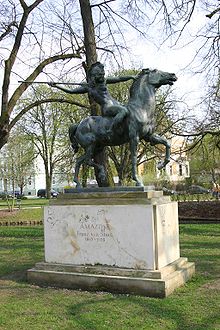Carinhall




Carinhall was the country residence of Hermann Göring, built on a large hunting estate northeast of Berlin in the Schorfheide forest between the lakes Großdöllner See and Wuckersee in the north of Brandenburg.
Named in honour of his Swedish first wife Carin Göring (1888–1931), it was constructed in stages from 1933 on a large scale, but in the manner of a hunting lodge. The main architect was Werner March, designer of the Olympic stadium in Berlin.
On 10 April 1935, Carinhall was the venue for Göring's wedding banquet with his second wife, Emmy Sonnemann.
Carinhall became the destination for many of Göring's looted art treasures from across occupied Europe.
Emmyhall
The Reichsjägerhof, Göring's smaller hunting lodge at Rominten in East Prussia (now Krasnolesye), in the Rominten Heath, was known as "Emmyhall" after his second wife.[citation needed]
Fate
To prevent Carinhall from falling into the hands of the advancing Red Army, the compound was dynamited on 28 April 1945 at Göring's orders by a Luftwaffe demolition squad. The art treasures were evacuated beforehand to Berchtesgaden.
Only the monumental entrance gates, a few foundation structures, and decorative stones remain from the building. A bronze statue by Franz von Stuck, Kämpfende Amazone (1897), once at Carinhall, is now at Eberswalde.

Legacy
In 1999 new interest was sparked by the book Görings Reich: Selbstinszenierungen in Carinhall[1] which saw treasure hunters drawn to the ruins, and concerns raised about the site becoming a neo-Nazi "shrine".[2] The state government of Brandenburg ordered the remains of the tomb of Göring's wife to be demolished.[citation needed]
See also
References
Sources
- Roger Manvell - Der Reichsmarschall. 1983. ISBN 3-8118-4370-2
- Leonard Mosley - The Reich Marshal: A Biography of Hermann Goering. 1975. ISBN 3-420-04727-4
- Carlos Díaz Domínguez - Tres colores en Carinhall 2011. ISBN 978-84-666-4192-0
